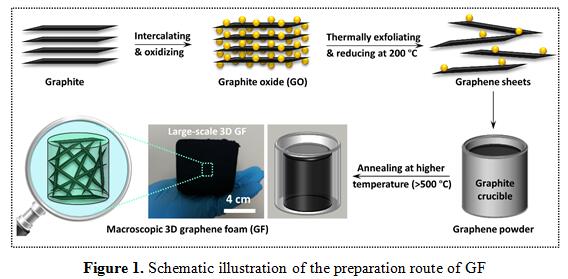Graphene has the record thermal conductivity of ~5300 W/m·K, large theoretical specific surface area of ~2630 m2/g, high electrical conductivity of ~6000 S/cm, etc., and thereby is frequently regarded as an ideal building block for constructing graphene foams (GFs), by which the chemical and physical properties of nanoscale 2D graphene sheets are expected to be transferred to macroscopic 3D GFs that are fairly promising in electromagnetic interference (EMI) shielding, water purification as well as energy storage.
Generally, GFs are mainly prepared by two techniques: hydrothermal and templating methods. The former is quite complex and time-consuming, especially for the self-assembly of graphene and subsequent freeze or supercritical drying treatment, while the latter always suffers from the partial breaking of the fragile graphene frameworks during the removal of hard templates based on nickel (Ni) foam, polyurethane (PU) foams and so forth.
Recently, a novel sintering strategy for efficient fabrication of GFs has been reported by Prof. Wenge Zheng and his research group in Ningbo Institute of Materials Technology and Engineering (NIMTE, CAS).As shown in Figure 1, large-scale GFs are facilely fabricated by immediately sintering low-temperature exfoliated graphene (LTEG) powder at a temperature over 500 °C. The LTEG powder can be prepared according to their previous technology (Patent: CN201110276666.6; Journal of Materials Chemistry C, 2013, 1: 50-53), thus the thermal exfoliation of graphite oxide at a temperature as low as 130 °C within minutes under ambient atmosphere, and the followed one-pot sintering process is capable of integrating 2D LTEG into 3D GFs and simultaneously accelerating the structural integrity of graphene by inducing its deoxygenation and repairing the defects. More importantly, the whole process can be finished within hours, usually less than 12 h. The resultant GFs with meso- and macroporous structure can not only shield ~99.21-99.99% of high-frequency electromagnetic power (8.2-12.4 GHz), but also adsorb large doses of common organic pollutants (~47-120 times of its own weight). In comparison with conventional hydrothermal and templating methods, the sintering strategy possesses more advantages in maneuverability, efficiency, and repeatability, benefiting for the mass production of high-performance and multifunctional GFs (Patent: CN201710051316.7; ACS Applied Materials & Interfaces, 2017, DOI: 10.1021/acsami.7b0240).

The work is financially supported by National Natural Science Foundation of China (51603218, 51473181, and 51573202), and Natural Science Foundation of Ningbo (2016A610269).
Prof. Wenge Zheng: wgzheng@nimte.ac.cn,
Prof. Bin Shen: shenbin@nimte.ac.cn

